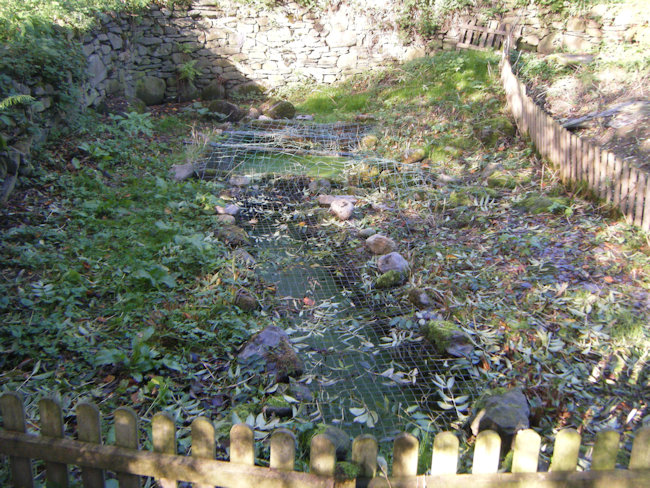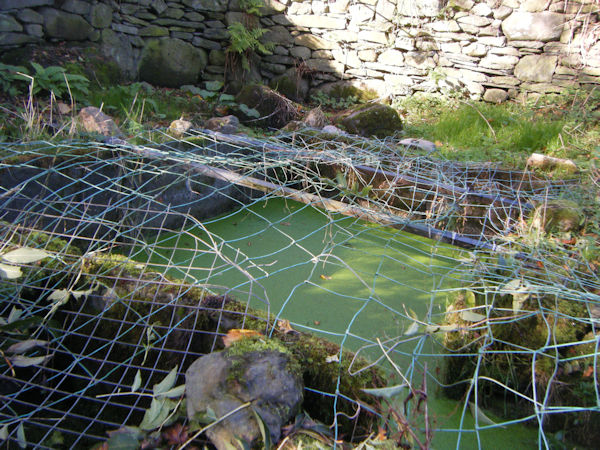 |
Dedication: Saint Tysilio/Sulien Location: Ffynnon Sulien Coordinates: 52.9861N, -3.3885W Grid reference: SJ068440 Heritage designation: Grade II listed building |
 |
Dedication: Saint Tysilio/Sulien Location: Ffynnon Sulien Coordinates: 52.9861N, -3.3885W Grid reference: SJ068440 Heritage designation: Grade II listed building |
There are a number of Welsh saints to whom the name "Sulien" could be applied: St Silin, a 6th century saint who seems to have been based in South Wales; St Sulien, the 6th century brother or cousin of St Mael; Bishop Sulien of St Davids; and St Tysilio, a 6th century prince. Both St Silin and Bishop Sulien can be safely ruled out here, which leaves Sulien and Tysilio, who may actually be one and the same. Whether Mael was actually related to Sulien, or whether they were simply just close associates, is not clear, but what is evident is that a saint named "Sulien" is known in both North Wales and Brittany (the latter being St Mael's birthplace). The only place that is known certainly to have borne a medieval joint dedication to the two saints is the hamlet of Cwm in Flintshire; elsewhere, Sulien is always the sole patron. This suggests that the pair were not interchangeable, and that Sulien's cult was mostly independent of Mael's. In fact, there is a large amount of evidence to suggest that this mysterious saint was actually St Tysilio, under another name.
Both Welsh and Brittonic traditions refer to a son of King Brochwel who was linked to Meifod, near Welshpool, and who spent some time living on an island in the Menai Strait. The Welsh name for this figure is Tysilio, and the Welsh name for this island is thus "Ynys Tysilio", meaning "Tysilio's Island"; however, his Brittonic title is Sulien, and in Brittany the island was referred to as "Enes Sulien" (at least according to Guy Alexis Lobineau's Les Vies des Saints de Bretagne, published in 1725). Both Welsh and Brittonic legends also state that this saint travelled to Brittany at some point during his lifetime, and there became a hermit. It is plausible that this saint met St Mael during his time in Wales (perhaps whilst he was Bishop of St Asaph), and the two collaborated on the foundation of a church in Cwm, before going their separate ways, as the spread of their medieval cults suggest. Indeed, the cult of Tysilio was particularly strong in this area, with another church and holy well dedicated to the saint located literally just down the road at Bryneglwys. Interestingly, The Llangollen Advertiser, on the 1st of November, 1901, complained that "Ffynon [sic] Silio road, near Corwen" was "in a wretched and filthy state"; I have seen Ffynnon Sulien referred to as "Ffynnon Silio" in several instances, "Silio" almost certainly being a variant of "Tysilio".
It is worth noting that there is some confusion regarding the exact nature of Corwen's patronage: currently, the church is dedicated to both Mael and Sulien, whilst most historical sources describe its patron as Sulien alone. The idea that the church is dedicated to both saints is likely a mistake that arose from the fact that the name Sulien is, in Wales, often automatically associated with St Mael. The fact that the holy well does not bear this joint patronage, unlike the holy well at Cwm in Flintshire, suggests that Sulien/Tysilio alone was Corwen's original tutelary saint.
Ffynnon Sulien itself undoutedly played a part in the medieval cult of Sulien/Tysilio. In particular, it is said that the spring's water was esteemed for curing rheumatism (it is surely not a coincidence that the well is encased in a medieval structure clearly meant for bathing and immersion), and for baptisms in the church. The fact that the well is located on the other side of the River Dee to the parish church has been cited as evidence that Ffynnon Sulien is not a medieval holy well (this concept was, strangely enough, propagated by the Royal Commission), for the simple reason that the water would have had to have been regularly brought over the river, a potentially dangerous task. However, a local history article published in the Corwen Advertiser on the 19th of December, 1916, quoted a local tradition that it was necessary to "cyrchu dwfr dros yr afon" ("fetch water over the river") for baptisms, suggesting it was simply an accepted part of life in Corwen.
Although the earliest reference that I have found to the existence of the holy well dates from the year 1700 (or thereabouts), the Historic Environment Record asserts that the name "Tythyn y ffynnon silien" was referred to in an unidentified document of 1564 (whilst this may well be true, the Historic Environment Record's information, at least regarding holy wells, is generally very inaccurate and unreliable), and additionally records that the "owner believes it was documented in the 12th century"; again, this could be true, but is likely not. Nonetheless, the site was definitely mentioned in or around the year 1700, when it was included in Edward Lhuyd's Parochialia as "Fynnawn Silian by RÓg Chappell". Several decades later, in 1778, the site was referenced by Thomas Pennant in his Tour of Wales; although Pennant did not refer to the spring by name, he did record that the "ſaint has his well here".
How exactly Ffynnon Sulien was used during this time is unclear, but belief in its supposed healing powers appears to have survived into the early 19th century, when Samuel Lewis attested that the water of the holy well "is efficacious in the cure of rheumatic complaints" in A Topographical Dictionary of Wales (1833). However, by the early 20th century it seems that these traditions had been forgotten, or at least were not readily known, as the report of the Royal Commission, following their inspection of the site on the 31st of July, 1913, makes distinct mention of the lack of traditions that they knew of regarding Ffynnon Sulien:
|
That this spring was formed into and used as a well at an early period in the history of Corwen may be considered as certain; its never-failing supply of cold and crystal water, and its admirable situation would render it in all periods a valued possession to a primitive community. But there is no evidence that it has been the object of a cult or tradition, or that it was ever the site of village assemblies. The well chamber measures 9 feet by 6 feet and is 4 feet 6 inches deep. It is flagged with stone slabs, and the sides are lined with similar slabs. The well bears the name of the local saint; but it should be noticed that it is situated at a considerable distance from the church, and, withal, on the other side of a deep and dangerous river which must have been impassable for a certain period of every year. Edward Lhuyd (or his correspondent) at the close of the 17th century gives a very complete description of the natural features and antiquarian remains of the parish, and furnishes an unusually complete account of its rivers and streams; but says nothing whatever of the holy well, or indeed of any well, though the saint's tomb is not omitted. It is therefore impossible to regard it as the clearly substantiated holy well of the parish. |
Unfortunately, whilst the Royal Commission's reports are usually extremely reliable sources of information, their statement relating to Ffynnon Sulien is riddled with errors, and its author seems to have been inexplicably determined to prove that the spring was not a medieval holy well, against all evidence. Firstly, the fact that the well was used for the healing of rheumatism, and the plain fact that it is dedicated to a local saint, is evidence that it was once the "object of a cult"; and secondly, Edward Lhuyd certainly did mention the site in his Parochialia (as referred to previously). These errors, lamentably, have found their way onto the Coflein database and thus it has been accepted as fact that Ffynnon Sulien is, as Coflein puts it, "not a holy well".
When I visited the site in the October of 2024, the medieval structure surrounding the spring appeared to be in good condition, although it had been covered in wire netting. The owner of the site was aware of the tradition that the well was once used to cure both eye problems and rheumatism, and mentioned the fact that an old "covenant" dictated that the owners of the nearby Rhug Chapel could take water from Ffynnon Sulien for baptisms whenever they wished. The spring's water is still used to supply the adjoining cottage.
 |
|
Access: Ffynnon Sulien is located on private land within the garden of a cottage that shares the name of the well; permission for visiting the site is to be obtained from there. |
Copyright 2025 britishholywells.co.uk